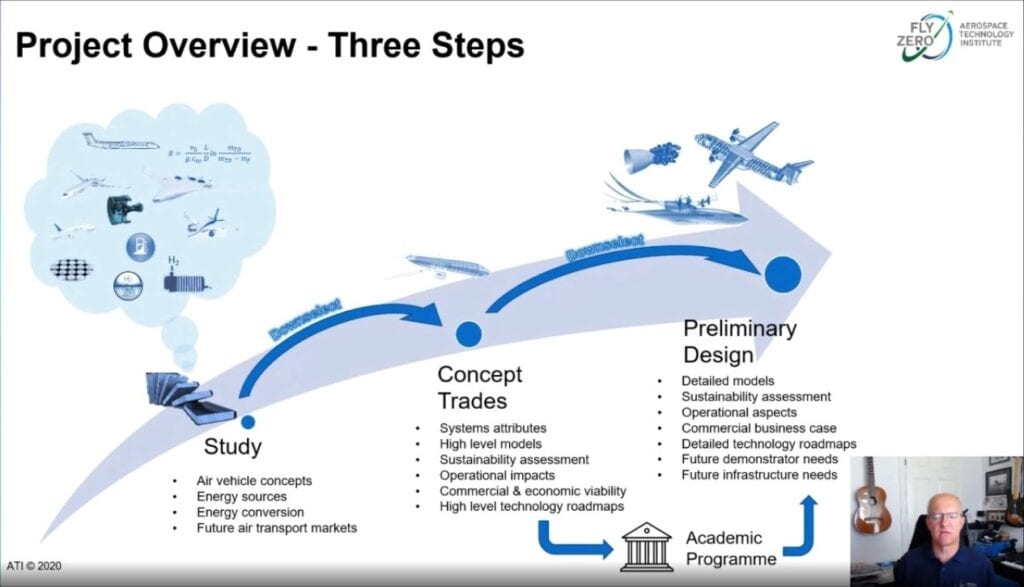
The Aerospace Technology Institute will bring more than one hundred people onboard for a year-long feasibility and design study of zero-emissions commercial aircraft. (ATI)
The UK’s Aerospace Technology Institute (ATI) will lead a one-year project to study design challenges and potential for a zero-emission commercial aircraft, a part of the Jet Zero Council launched by Prime Minister Boris Johnson in July to tackle climate change and establish national leadership on carbon neutral long-haul air travel.
Executives from ATI, speaking during a webinar about the project, described it as an effort to holistically explore the potential to realize a zero-carbon emission commercial aircraft, with 80 seats or more, by the end of the decade, with potential for a follow-on phase to include a major demonstrator project.
“The prime minister spoke about his ambition to achieve some bold carbon reduction … he’s completely bought into it, and they see FlyZero as forming a key component of that mission,” said Gary Elliot, CEO of ATI. “This is a transformative project that has the potential to have a follow-on moonshot phase if we get it right.”
Working with partners across the UK’s aerospace sector, ATI intends to bring up to 110 people into its organization as “secondees,” where they will work for the FlyZero project full-time with salaries and expenses paid by ATI. Most will be engineers, but smaller teams will also be stood up to examine markets, commercial viability, production, lifecycle and supply chain issues.
The project will begin with an initial study phase, collecting and structuring known information on air vehicle concepts, energy sources and conversion, and future air transport markets, according to Simon Weeks, ATI’s chief technology officer.
“Then, we’ll down-select ideas that we think are most appropriate and carry out a concept trade study, starting to pull those views of aircraft and aircraft systems … how they might perform, how sustainable they might be, what operational issues there might be, and whether we have a view at that stage on what the commercial and operational viability might be,” Weeks said during the broadcast.
In the final project phase, one or more designs will be chosen through a further down-select for a preliminary design phase, where Weeks said the intent is to develop concepts into much more fleshed-out models and understand their performance and technological challenges in greater detail.
“We’re looking to see what is the most likely commercial zero net carbon aircraft in the 2030s and what addition does the UK need to do to be ready for that? What demonstrator projects do we need to do downstream from this study?” Weeks said. “[This project will] take one or more designs to a reasonable level of detail, and once you get into a level of detail, only then you start to tease out some of the key technical issues.”
In addition to potential follow-on projects, the results of the one-year FlyZero program will be disseminated back into the UK aerospace community to further encourage progress toward zero emissions aircraft.
ATI officials said the initial FlyZero project will only include UK partners, as part of its goal is to create a UK consortium and bolster national competitiveness in pursuit of zero-carbon aviation solutions, but later follow-on projects may look to include international collaboration.
“If you take the [Intergovernmental Panel on Climate Change] scenarios in order to achieve 1.5 or even 2 degrees [Celsius] warming by the end of the century, and overlay the trajectory for aviation in terms of CO2 output, the sector is on track by 2050 to become a major, if not the major, contributor to CO2 emissions,” said James McMicking, chief strategy officer for ATI.
“Today, it’s only two percent, but other sectors will find it easier than aerospace to reduce their carbon emissions.”